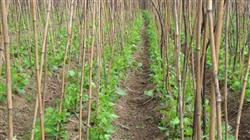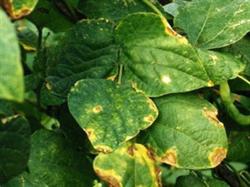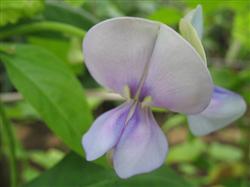High yield and High efficiency cultivation of Autumn Kidney Bean

Autumn kidney bean, also known as knife bean and kidney bean, is one of the main autumn vegetables in Dongtai City, Jiangsu Province. It has been popularized and planted in more than 20, 000 mu from 2004 to 2007, with a yield of 1300-1400 kg per mu and an output value of 1800-2200 yuan. In addition to the supply market, the products are mostly used for foreign trade dehydration processing. First, arrange the stubble reasonably. There are more autumn kidney bean stubble, which can be used not only for leafy vegetables, but also for eggplant fruits or melons. Autumn kidney beans are also the best crops for corn, especially vine varieties, which can climb on corn. Interplanting vine varieties such as kidney bean, tomato and cucumber, sowing on the edge of the pole before pulling seedlings, the frame wood of the previous crop can be used. Dwarf varieties can be interplanted with a variety of vegetables. Second, soil preparation and fertilization. Choose sandy loam with deep soil layer and good permeability. In autumn, it is best to sunburn and weed, prepare the land after ploughing, spread basic fertilizer, apply 1000-3000 kg of ash and miscellaneous fertilizer per mu, acid soil and calcium-deficient plots, apply an appropriate amount of lime powder. Third, proper close planting. The selection of early-maturing, aging-resistant and green pod varieties for quick-frozen export processing requires that the varieties are round, straight and tender, non-gluten, non-leathery film, and the utilization rate of raw materials is more than 90%. The trailing varieties are Luzhu, 78-209, etc., while the dwarf varieties are American suppliers, Nanhu, France and so on. It is generally sown from the end of July to the beginning of August and blossom and bear pods in cool autumn. The row spacing is 60 cm, the plant spacing is reduced to 20 cm or one more seedling is left in each hole. Fourth, field management. ⑴ and time fixed seedling: set the seedling in time after the whole seedling, leave 2 seedlings in each hole, remove the weak and stay strong, go to the small and stay big, go to the disease and stay healthy. ⑵ intermediate ploughing and weeding: shallow and moderate ploughing at seedling stage to remove weeds in the field. ⑶ scaffolding lead vine: insert the shelf when the main stem begins to draw vine. There are weaving style, herringbone type and hedge type, and the "human" frame is the most commonly used. When inserting the frame, 1-2 braces are obliquely inserted at both ends of the frame to reinforce it. After inserting the frame, it is necessary to draw the vine manually (to the left) to avoid "twisting the vine". The height of the pole should be 1.5-2 meters. ⑷ fertilizer and water operation. The principles of water and fertilizer management are dried flowers, warm pods, pre-control and post-promotion. Less fertilizer before anthesis, more fertilizer after anthesis, repeated application at podding stage, combined application of nitrogen, phosphorus and potassium, re-application of potash fertilizer; timely topdressing of shelf fertilizer, generally 2000-2500 kg of human and animal manure per mu and pond opening hole application Heavy application of flower and pod fertilizer, kidney beans need a large amount of fertilizer after podding, should focus on watering, topdressing generally apply 45% compound fertilizer 25-30 kg per mu, podding period in case of a long drought without rain, should be timely watering, generally watering once every 5-7 days to maintain the maximum field capacity of 60-70%; turn flowers in time. In the later stage of harvest, most of the lower yellow leaves were removed and fertilized continuously for 2-3 times to prolong the harvest period for 10-15 days. Fifth, pest prevention and control. The main pests are cabbage worm, bean pod borer, aphids, etc. 2.5% deltamethrin 15-25 ml per mu is sprayed with 30-40 kg of water; anthracnose, rust and other diseases are controlled with 500 times of 70% methyl topiramate wettable powder. Sixth, harvest in time. The harvest time of dwarf species is about 40 days from sowing to the beginning, the harvest time is 15-20 days, and the harvest time of vine species is about 30 days. In general, young pods are harvested 10-15 days after flowering, and products used for dehydration and canning are strictly harvested 3-5 days earlier than fresh edible pods.
- Prev

Greenhouse tomato with kidney bean
Symptoms: the disease can occur from seedling stage to adult stage, mainly harming leaves, stems, pods and seeds. The cotyledons of the diseased seedlings showed a reddish-brown ulcerated shape, and the disease spot at the base of the stem surrounded the stem for a week, showing a reddish-brown ulcerated shape, which made the seedlings break and die. Prevention and control methods: 1. Implement crop rotation for more than 3 years. 2. Never a disease-free field.
- Next

Technical points of interplanting kidney beans in cotton field
First, to select improved varieties, we should choose varieties with wide adaptability, strong stress resistance, high pod setting rate and high yield. Second, when sowing and cultivation at the right time, we should grasp the appropriate sowing time and choose full and glossy seeds to make the plant growth and development in a good environment, reduce flowers and pods and improve.
Related
- The first cup of black tea in spring, the flavor and history of tea gardens in Kenya, Africa
- The computer can not only choose potatoes, but also grow tea rice. AI will grow winter oolong tea champion.
- It is not only the inflated tea bitten by insects, but also engraved with the four seasons tea in Beipu.
- The Oriental Beauty Tea Festival in Zhuxian County takes the stage at the weekend to experience the plus-size feast of oil tea.
- & quot; Oriental Beauty Tea & Exploration of Emei in Hsinchu, the hometown of quot;
- The new variety of strawberry "Tainong 1" dessert is the first choice with mellow aroma. Crimson gorgeous
- History of Tea in Taiwan: from Wild Inner Mountain to Export Tea Garden
- Two types of Taiwan Oriental Beauty Black Tea won the British three-Star Award for Childhood Tea Xiang Zhang Jiaqi changed from pilot to champion tea maker.
- Banana species and varieties: the planting history of Taiwan Xianren banana and dwarf banana is long, is banana disease resistant?
- Coffee planting Technology: Qianjie Coffee from Seedling to harvesting

